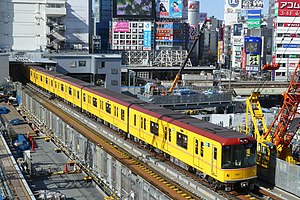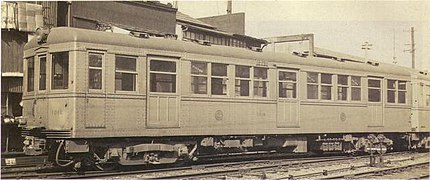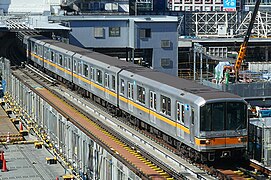You can help expand this article with text translated from the corresponding article in Japanese. (August 2021) Click for important translation instructions.
|
| This article needs additional citations for verification. Please help improve this article by adding citations to reliable sources. Unsourced material may be challenged and removed. Find sources: "Tokyo Metro Ginza Line" – news · newspapers · books · scholar · JSTOR (December 2010) (Learn how and when to remove this message) |
| Tokyo Metro Ginza Line | |
|---|---|
 | |
 A Ginza Line 1000 series train at Shibuya Station A Ginza Line 1000 series train at Shibuya Station | |
| Overview | |
| Other name(s) | G |
| Native name | 東京メトロ銀座線 |
| Owner | |
| Line number | 3 |
| Locale | Tokyo |
| Termini | |
| Stations | 19 |
| Color on map | Orange (#FF9500) |
| Service | |
| Type | Rapid transit |
| System | Tokyo subway |
| Operator(s) | Tokyo Metro |
| Depot(s) | Shibuya, Ueno |
| Rolling stock | Tokyo Metro 1000 series (6 cars) |
| Daily ridership | 943,606 (2017) |
| History | |
| Opened | 30 December 1927; 97 years ago (30 December 1927) |
| Technical | |
| Line length | 14.3 km (8.9 mi) |
| Number of tracks | Double-track |
| Track gauge | 1,435 mm (4 ft 8+1⁄2 in) standard gauge |
| Minimum radius | 94.183 m (309.00 ft) |
| Electrification | 600 V DC (third rail) |
| Operating speed | 65 km/h (40 mph) |
| Train protection system | New CS-ATC |
| Maximum incline | 3.3% |
The Tokyo Metro Ginza Line (東京メトロ銀座線, Tōkyō Metoro Ginza-sen) is a subway line in Tokyo, Japan, operated by Tokyo Metro. The official name is Line 3 Ginza Line (3号線銀座線, 3-gōsen Ginza-sen). It is 14.3 km (8.9 mi) long and serves the wards of Shibuya, Minato, Chūō, Chiyoda, and Taitō. It is the oldest subway line in Asia, having opened in 1927.
The line was named after the Ginza commercial district in Chūō, Tokyo, under which it passes. On maps, diagrams and signboards, the line is shown using the color orange, and its stations are given numbers using the letter "G".
Operations
Almost all Ginza Line trains operate on the line's full length from Asakusa to Shibuya. However, two trains depart in the early morning from Toranomon, and some late-night trains from Shibuya are taken out of service at Ueno. Along with the Marunouchi Line, it is self-enclosed and does not have any through services with other railway lines.
On weekdays, trains run every 2 minutes 15 seconds in the morning and evening peak and every 5 minutes during the daytime. The first trains start from Shibuya and Asakusa at 05:01, and the last ones reach Shibuya at 00:37, and Asakusa at 00:39.
History

The Ginza Line was conceived by a businessman named Noritsugu Hayakawa, who visited London in 1914, saw the London Underground and concluded that Tokyo needed its own underground railway. He founded the Tokyo Underground Railway (東京地下鉄道, Tōkyō Chika Tetsudō) with Baron Furuichi Kōi in 1920, and began construction on September 27, 1925, after raising ¥6.2 million of the ¥35 million initially required to fund the project.

Originally, the Ginza Line was proposed to open from Shimbashi to Asakusa all at once, but because of a recession following the Great Kanto Earthquake, it became difficult to raise funds for the line. The portion between Ueno and Asakusa was completed on December 30, 1927, and publicized as "the first underground railway in the Orient". Upon its opening, the line was so popular that passengers often had to wait more than two hours to ride a train for a five-minute trip.
On January 1, 1930, the subway was extended by 1.7 km (1.1 mi) to temporary Manseibashi Station, abandoned on November 21, 1931 when the subway reached Kanda, 500 meters (1,600 ft) further south down the line. The Great Depression slowed down construction, but the line finally reached its originally planned terminus of Shimbashi on June 21, 1934.
In 1938, the Tōkyō Rapid Railway (東京高速鉄道, Tōkyō Kōsoku Tetsudō), a company tied to the predecessor of today's Tokyu Corporation, began service between Shibuya and Toranomon, later extended to Shimbashi in 1939. The two lines began through-service interoperation in 1939 and were formally merged as the Teito Rapid Transit Authority ("Eidan Subway" or "TRTA") in July 1941 in accordance with the Land Transport Business Coordination Law (陸上交通事業調整法, Rikujō-kōtsu jigyō-chōsei-hō).
The "Ginza Line" name was applied in 1953 to distinguish the line from the new Marunouchi Line. In the postwar economic boom, the Ginza Line became increasingly crowded. The new Hanzōmon Line began to relieve the Ginza Line's traffic in the 1980s, but the Ginza Line is still quite crowded as it serves major residential, commercial, and business districts in central Tokyo. According to a 2018 release of Tokyo Metropolitan Bureau of Transportation, the Ginza Line is the seventh most crowded subway line in Tokyo, running at 160% capacity between Akasaka-mitsuke and Tameike-sannō stations.
Automatic train control (ATC) and train automatic stopping controller (TASC) were activated on the Ginza Line on July 31, 1993, replacing the previous mechanical automatic train stop (ATS) system. This allowed for an increase in the maximum operating speed limit from 55 km/h (34 mph) to 65 km/h (40 mph), which came into effect on August 2, 1993, and hence enabled a corresponding increase in the line's route capacity and train frequency. The newest station on the line, Tameike-sannō Station, opened in 1997 to provide a connection to the newly built Namboku Line.
The line, station facilities, rolling stock, and related assets were inherited by Tokyo Metro after the privatization of the Teito Rapid Transit Authority (TRTA) in 2004.
Station list
Being the oldest line on the Tokyo Metro, stations are also the closest to the surface—generally no more than one and a half stories underground. The western end of the line enters Shibuya Station located on the third-floor of a building that is located in a depression.
| No. | Station | Japanese | Distance (km) | Transfers | Ward | |
|---|---|---|---|---|---|---|
| Between stations |
From Shibuya | |||||
| G01 | Shibuya | 渋谷 | - | 0.0 |
|
Shibuya |
| G02 | Omote-sandō | 表参道 | 1.3 | 1.3 |
|
Minato |
| G03 | Gaiemmae | 外苑前 | 0.7 | 2.0 | ||
| G04 | Aoyama-itchōme | 青山一丁目 | 0.7 | 2.7 |
| |
| G05 | Akasaka-mitsuke | 赤坂見附 | 1.3 | 4.0 |
| |
| G06 | Tameike-sannō | 溜池山王 | 0.9 | 4.9 |
|
Chiyoda |
| G07 | Toranomon | 虎ノ門 | 0.6 | 5.5 |
|
Minato |
| G08 | Shimbashi | 新橋 | 0.8 | 6.3 |
| |
| G09 | Ginza | 銀座 | 0.9 | 7.2 |
|
Chūō |
| G10 | Kyōbashi | 京橋 | 0.7 | 7.9 | ||
| G11 | Nihombashi | 日本橋 | 0.7 | 8.6 |
| |
| G12 | Mitsukoshimae | 三越前 | 0.6 | 9.2 |
| |
| G13 | Kanda | 神田 | 0.7 | 9.9 |
|
Chiyoda |
| G14 | Suehirocho | 末広町 | 1.1 | 11.0 | ||
| G15 | Ueno-hirokoji | 上野広小路 | 0.6 | 11.6 |
|
Taitō |
| G16 | Ueno | 上野 | 0.5 | 12.1 |
| |
| G17 | Inarichō | 稲荷町 | 0.7 | 12.8 | ||
| G18 | Tawaramachi | 田原町 | 0.7 | 13.5 | ||
| G19 | Asakusa | 浅草 | 0.8 | 14.3 |
| |
- Due to the distance between the Ginza and Hanzomon/Den-en-toshi lines at Shibuya, transfers between the two lines are announced at Omotesandō.
Rolling stock

Since April 2012, the Ginza Line uses a fleet of 40 six-car Tokyo Metro 1000 series EMUs which have a maximum speed of 80 km/h (50 mph). Each car is 16 m (52 ft 6 in) long and 2.55 m (8 ft 4 in) wide, with three doors on each side. They are powered by a third rail electrified at 600 V DC. Both the Ginza Line and the Marunouchi Line are the only Tokyo Metro lines to use 1,435 mm (4 ft 8+1⁄2 in) standard gauge and third rail electrification, while subsequent lines employ narrow gauge (1,067 mm (3 ft 6 in)) rails and 1,500 V DC overhead power supply to accommodate through services.
Cars are stored and inspected at Shibuya Depot located after Shibuya Station and at Ueno Inspection Division (上野検車区, Ueno-kensha-ku), a facility located northeast of Ueno Station with both above-ground and underground tracks. The facility is capable of holding up to 20 6-car formations. Major inspections are carried out at Tokyo Metro's Nakano depot on the Marunouchi Line, forwarding over a connecting track at Akasaka-Mitsuke.
Former rolling stock
- 100 series (1938–1968)
- 1000 series (TRTA) (1927–1968)
- 1100 series (1930–1968)
- 1200 series (1934–1986)
- 1300 series (1949–1986)
- 1400 series (1953–1985)
- 1500 series (1954–1986)
- 1500N series (1968–1993)
- 1600 series (1955–1986)
- 1700 series (1956–1986)
- 1800 series (1958–1986)
- 1900 series (1958–1987)
- 2000 series (1958–1993)
- 01 series 6-car EMUs, from 1983 until March 2017
The last remaining 01 series trains were withdrawn from regular service on 10 March 2017.
-
A 100 series EMU car
-
 One of the original 1000 series cars operated on the Tokyo Underground Railway between Ueno and Asakusa. The last car was retired in 1968.
One of the original 1000 series cars operated on the Tokyo Underground Railway between Ueno and Asakusa. The last car was retired in 1968.
-
 Original 1000 series car preserved at Tokyo Subway Museum
Original 1000 series car preserved at Tokyo Subway Museum
-
A Ginza Line 1200 series EMU in 1951
-
 A Ginza Line 2000 series set in 1977
A Ginza Line 2000 series set in 1977
-
 A Ginza Line 01 series EMU
A Ginza Line 01 series EMU
References
- Shaw, Dennis and Morioka, Hisashi, "Tokyo Subways", published 1992 by Hoikusha Publishing
- Tokyo Metro station ridership in 2017 Train Media (sourced from Tokyo Metro) Retrieved May 28, 2018.
- In its current form in 1939
- Yamamoto, Tsutomu; Matsukawa, Shunsuke; Hisawa, Haruo (2010). "Diagnosis of Ginza Line Subway Tunnel, the Oldest in Asia, by Acquiring Data on Deterioration Indices". Information Technology in Geo-Engineering. IOS Press: 190–198. doi:10.3233/978-1-60750-617-1-190. Archived from the original on May 25, 2021. Retrieved 22 August 2014.
- ^ Hornyak, Tim (16 December 2017). "Heart of gold: The Ginza Line celebrates its 90th birthday". Japan Times. Archived from the original on December 9, 2020. Retrieved 29 December 2017.
- Rea, G.B. (December 1920). "The Tokyo Subway Plans". Far Eastern Review. XVI (12): 681.
- Metropolis, "Commute", June 12, 2009, p. 07. Capacity is defined as all passengers having a seat or a strap or door railing to hold on to.
- 足立武士「CS-ATCの導入 その効果と展望」『鉄道ピクトリアル』1995年7月臨時増刊号(通巻608号)p72 – 75, 電気車研究会
- 帝都高速度交通営団史, p.612
- "「営団地下鉄」から「東京メトロ」へ" [From "Teito Rapid Transit Authority" to "Tokyo Metro"]. Tokyo Metro Online. 2006-07-08. Archived from the original on 16 May 2012. Retrieved 29 May 2022.
- 銀座線に新型車両1000系を導入 [New 1000 series trains to be introduced on Ginza Line] (PDF). News release (in Japanese). Tokyo Metro. 17 February 2011. Retrieved 18 February 2011.
- 東京を走り33年…地下鉄銀座線01系が営業運転終了 12日ラストラン [Tokyo Metro Ginza Line 01 series ends revenue service after running in Tokyo for 33 years – Final run on 12 March]. Iza (in Japanese). Japan: Sankei Digital Inc. 10 March 2017. Archived from the original on 11 March 2017. Retrieved 11 March 2017.
External links
- Ginza Line overview (Tokyo Metro) (in Japanese)
| Transit in Greater Tokyo | |
|---|---|
| Shinkansen | |
passing through Central Tokyo |
|
| |
in satellite cities or suburbs | |
in satellite cities or suburbs | |
| |
| Other commuter rail lines | |
| Trams | |
| Monorails | |
| People movers | |
| Hinterland | |
| Funiculars and aerial lifts | |
| Public ferries | |
| Major terminals | |
| Miscellaneous |
|
